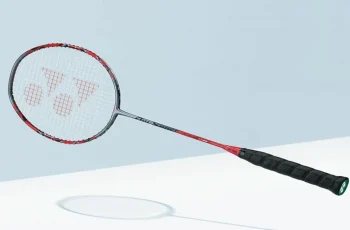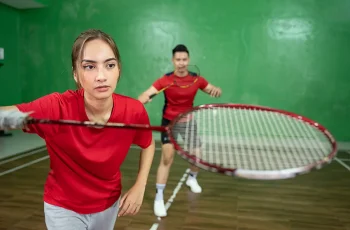Last updated on August 8th, 2024
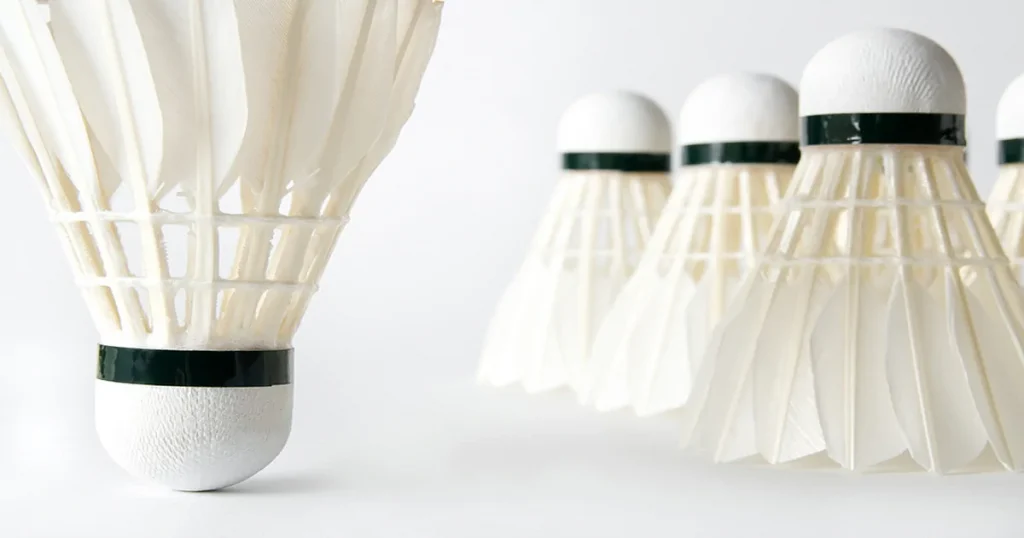
The Badminton Shuttlecock aka Shuttle Or Birdie
I’m sure you know what a shuttlecock is right? However did you know there are several different kinds of shuttlecock types that you choose from? I will be explaining all of this, the differences, when use should choose a certain type of shuttle and of course how much they cost in this article.
What is a birdie in badminton?
The shuttlecock is also known to many as the badminton shuttlecock or birdie or even bird. It’s the projectile used by players to hit back and forth over a net. The shuttlecock or birdie is a conical shape with overlapping feathers going into a cork base. The feathers can be replaced by nylon or plastic to produce a cheaper option.
The cork is then covered with leather material, again depending on the type of shuttlecock it may a type of plastic or rubbery material. The cork gives the shuttlecock weight so when hit it will always fly cork first, thus enabling it to be returned.
Other names for the shuttlecock include “Shuttlecork” but many people now simply refer to the Shuttlecock as the “Shuttle”.
Why is a shuttlecock called a birdie? That is due to the fact that the shuttle shares certain characteristics with birds. The main similarity is being able to fly through the air at speed along with it being made from feathers!
Aerodynamically the shuttlecock is incredibly stable making it perfect for the long rallies we sometime see in matches.
Why are there different kinds of shuttlecocks?
As I mentioned earlier the shuttlecock comes in basically two varieties. Feather or synthetic (nylon shuttlecock or plastic shuttlecock). There are of course many different types within these two categories, I will mention a few of these later.
Type 1: Feather Shuttlecock
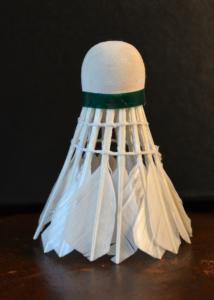
These are used by professional players and the serious amateurs. Why? Well basically they fly better, I’m sure there’s all kind of cool science to explain it. Put simply the speed and the flight is far superior!
Type 2: The Synthetic: Nylon Shuttlecock
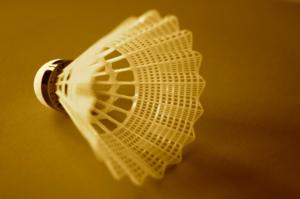
These are made out nylon/plastic instead of feathers and have the advantage of being durable and ready to use straight out of the tube!
This is the type most people will have used at some point and are ideal when you just want a game inside or outside. There are many types of these synthetic nylon or plastic shuttle with varying price and quality.
Why Doesn’t Everybody Just Use Feather Shuttlecock?
Well put simply they aren’t that durable and the feathers can become brittle. In fact in order for the feathers to be used they are often placed in a humidifier for around 4 hours. This ensures the feathers perform as required.
You can instead of placing them in a humidifier box place a moist sponge in the feather end of the shuttle tube, this should have the same effect. Just make sure you don’t put the moist sponge at the cork end as this will not have the same affect.
Which Shuttlecock Is Best For Badminton?
The short answer is feather produces a better flight through the air. If you want the best experience the you should opt for a feather shuttle.
However if you want durability and therefore better value, I recommend choosing a nylon shuttle.
Badminton Shuttlecock Prices
Let’s take a look at the different types of shuttles that are currently on sale:
- Goose Feather
- Duck Feather
- Plastic
- Nylon
Prices and quality vary but you can pick up 12 Goose Feather shuttles for around £14 to £35 from Amazon UK, $15 to $50 from Amazon.com or ₹1700 – ₹3000 from Amazon India.
Nylon is a lot cheaper and great for casual play.
This page contains affiliate / associate links. By buying through the links we may receive a commission for the sale. This has no effect on the price you pay.
What Is Shuttlecock Speed? & What Do The Different Speed Ratings Mean?
Once you have decided between the feather or a nylon shuttlecock, you need to think about the speed ratings. You will notice a number on the tube which relates to the speed the shuttlecocks are rated at.
Speeds range from 75 – 79 (slowest to quickest), but this is also dependant on the conditions where the shuttle is being used. Basically it comes down to slow, medium and fast, in reference to how quickly the shuttle can cover distance.
What Speed Shuttlecock Should I Use?
Temperature, altitude & humidity in the environment all play a part in determining which shuttle speed you should choose. To give you some idea, in the UK & Europe the 78 rated shuttles tend be used regularly. I would not concern yourself too much about this if you are a beginner.
Here’s a quick guide to help you choose the right shuttle speed.
| Shuttle Speed | Altitude Suited | Temperature |
| 75 – Slow | Above Sea Level | Very Hot (30+ Degrees) |
| 76 – Quite Slow | Sea Level | Hot (25-30 Degrees) |
| 77 – Average Speed | Sea Level | Average Temp (15-25 Degrees) |
| 78 – Quite Fast | Below Sea Level | Cold (0 – 15 Degrees) |
| 79 – Fast | Below Sea Level | Very Cold (Below Freezing) |
AirBadminton
There’s also a new shuttle developed for Air Badminton. These are intended for outdoor play, in fact the second generation of the AirShuttle are available now to purchase.
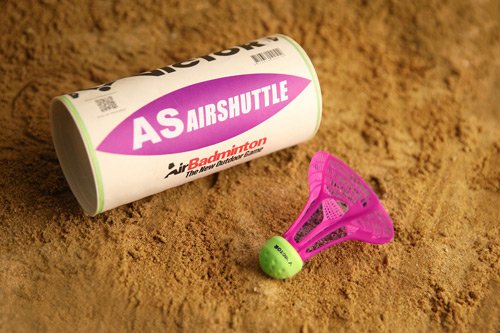
What Shuttlecock Brands Are There?
Yonex: Shuttles, Rackets etc..
Supplier of feather shuttlecocks to most of the major professional badminton tournaments.
Yonex are also the biggest sponsor in badminton and regarded by most as having the some of the best equipment for the sport.
RSL: Shuttles
Another well known name in badminton circles, RSL (Reinforced Shuttlecocks Ltd) origins date back to London, England 1928.
Wilson: Shuttles, Rackets, etc..
American sports equipment supplier Wilson is known for many sports. They include Badminton, Tennis, Squash, Baseball, Basketball, American Football and Golf.
Carlton: Shuttles, Rackets, etc..
Based mainly at Camberley, England Carlton has worked with some of the top players in the sport producing quality rackets and shuttles.
VICTOR: Shuttles, Rackets, etc..
From China we have, Victor International makers of badminton equipment. There are also a big sponsor within the professional game.
How Are Shuttlecocks Made?
Professional shuttles that are used in tournaments are made up of 16 goose or duck feathers that are glued together and inserted into a cork head.
First the feathers are washed and cut to shape. Then a piece of cork is shaped and covered with a layer of artificial leather. The next step sees the feathers inserted into the cork by machine and adjusted until the shape is correct. Once the shape is right threads are tied and glue is applied, this ensures the shape is maintained.
Finally the shuttles need to be tested for flight and distance accuracy / consistency. After that the birdie is ready for packing and shipping. The shuttle is now ready for action on the badminton court.
Let’s take a look at the Yonex factory in action!
Conclusion: The Shuttlecock aka Birdie or Shuttle
Now you know what to look out for when purchasing your shuttles. Whether its the brand of shuttlecock or speed and type we’ve covered it. If you just want a bit of fun choose a nylon birdie from any of the brands listed above.
How much you want to pay will obviously be a factor but unless you’re playing regularly you don’t need to spend too much.
For those of you playing regularly you will need to pay a bit more for durability. The best advice I can give is to check out a few reviews before buying. If you decide to opt for the feather variety don’t forget you need to look after them or the feathers will become dry and brittle.
That’s why I would only recommend feather shuttlecocks if you play at good to high level and often. You can get really good nylon ones which should last more than just a few games.
Should you choose feathered or Synthetic shuttlecocks? It all depends on what you want level you’re at. Serious competition or just a bit of fun.
